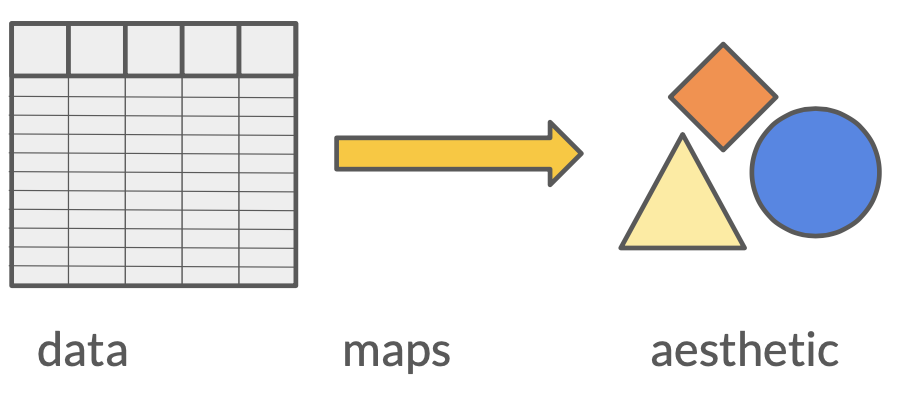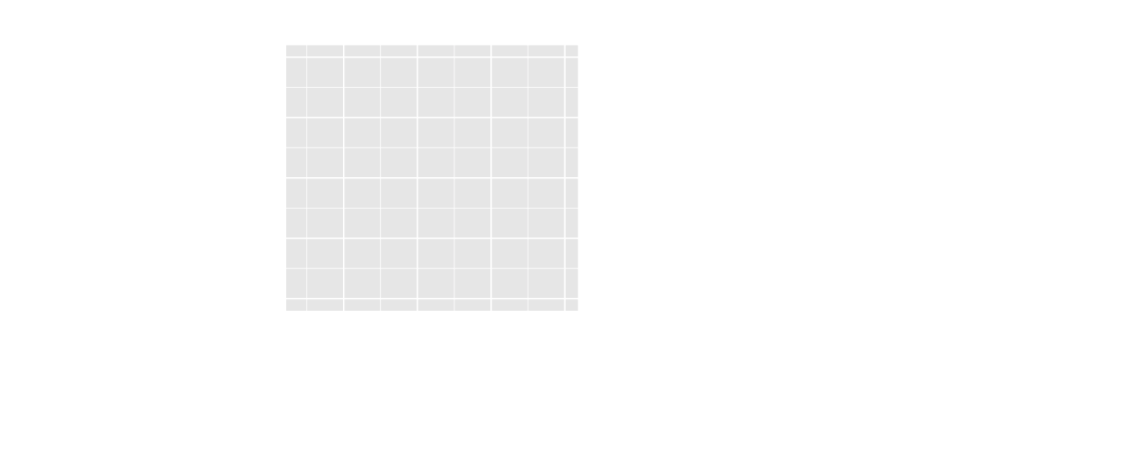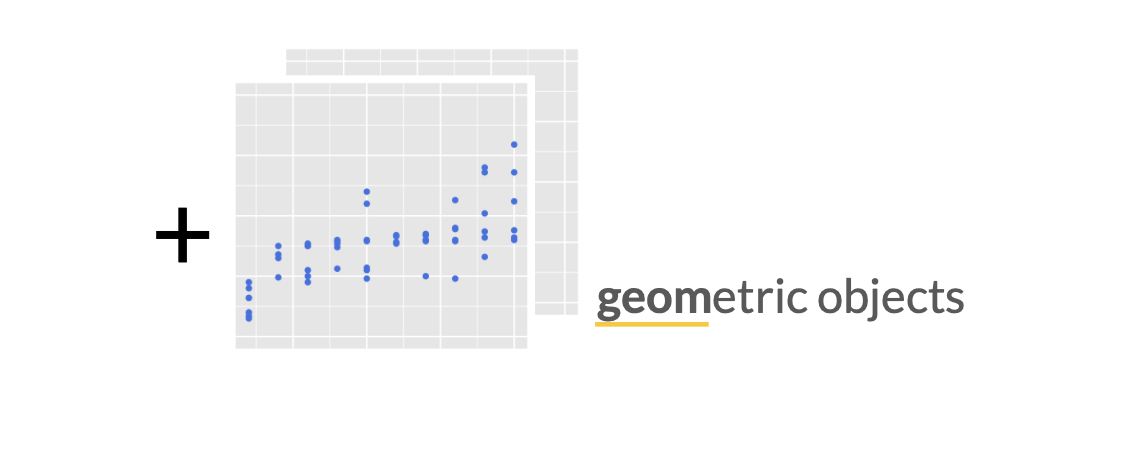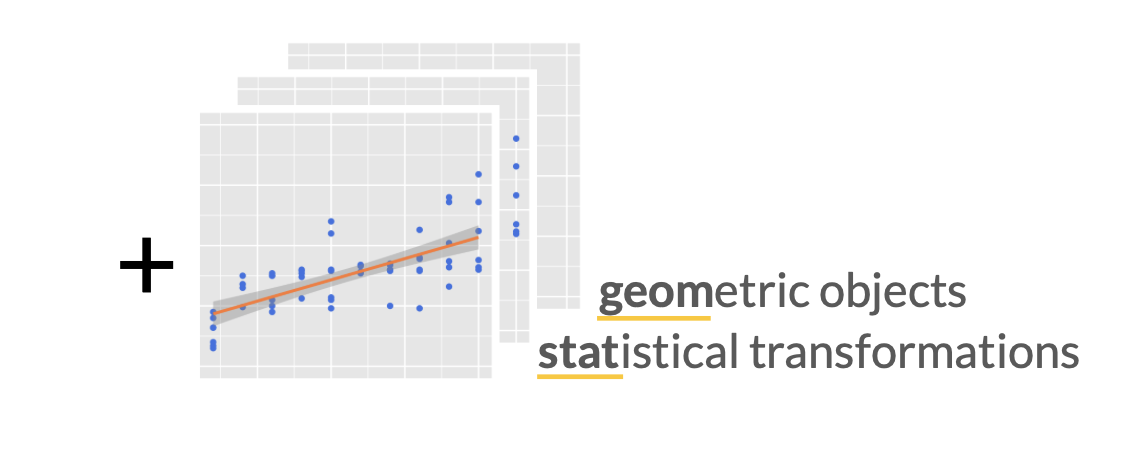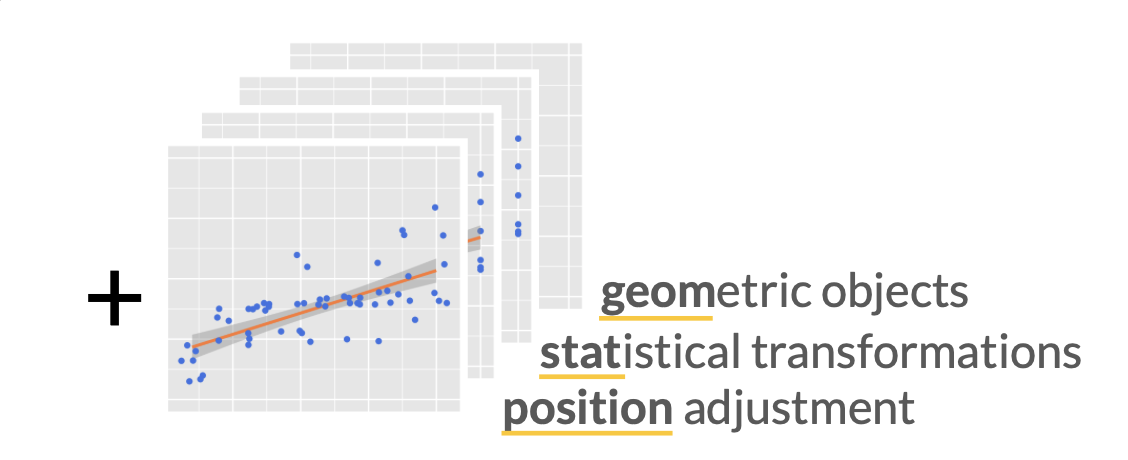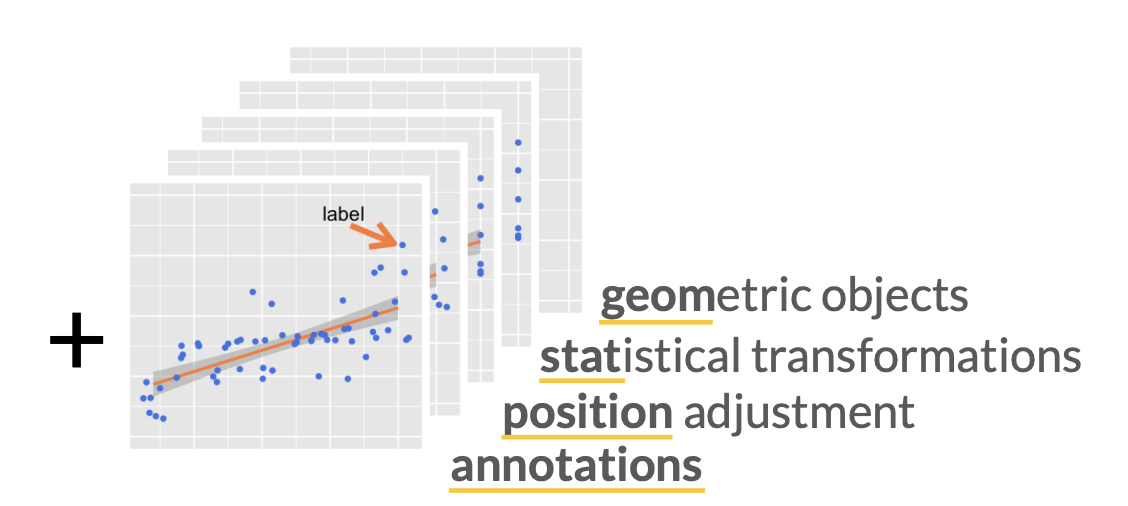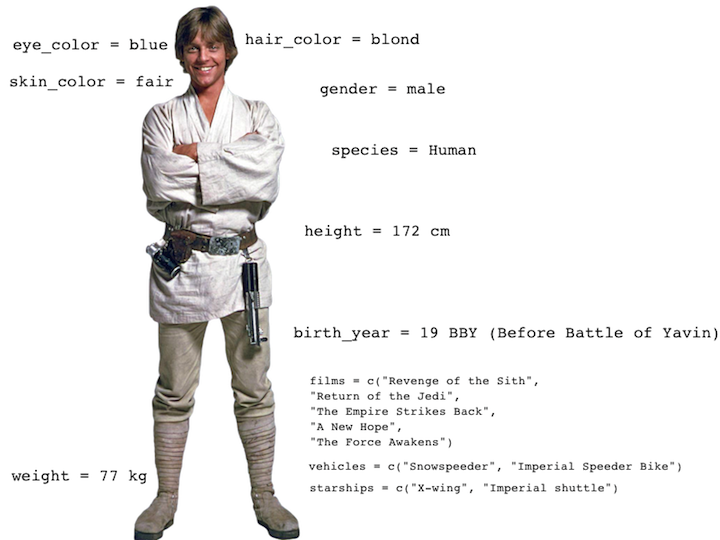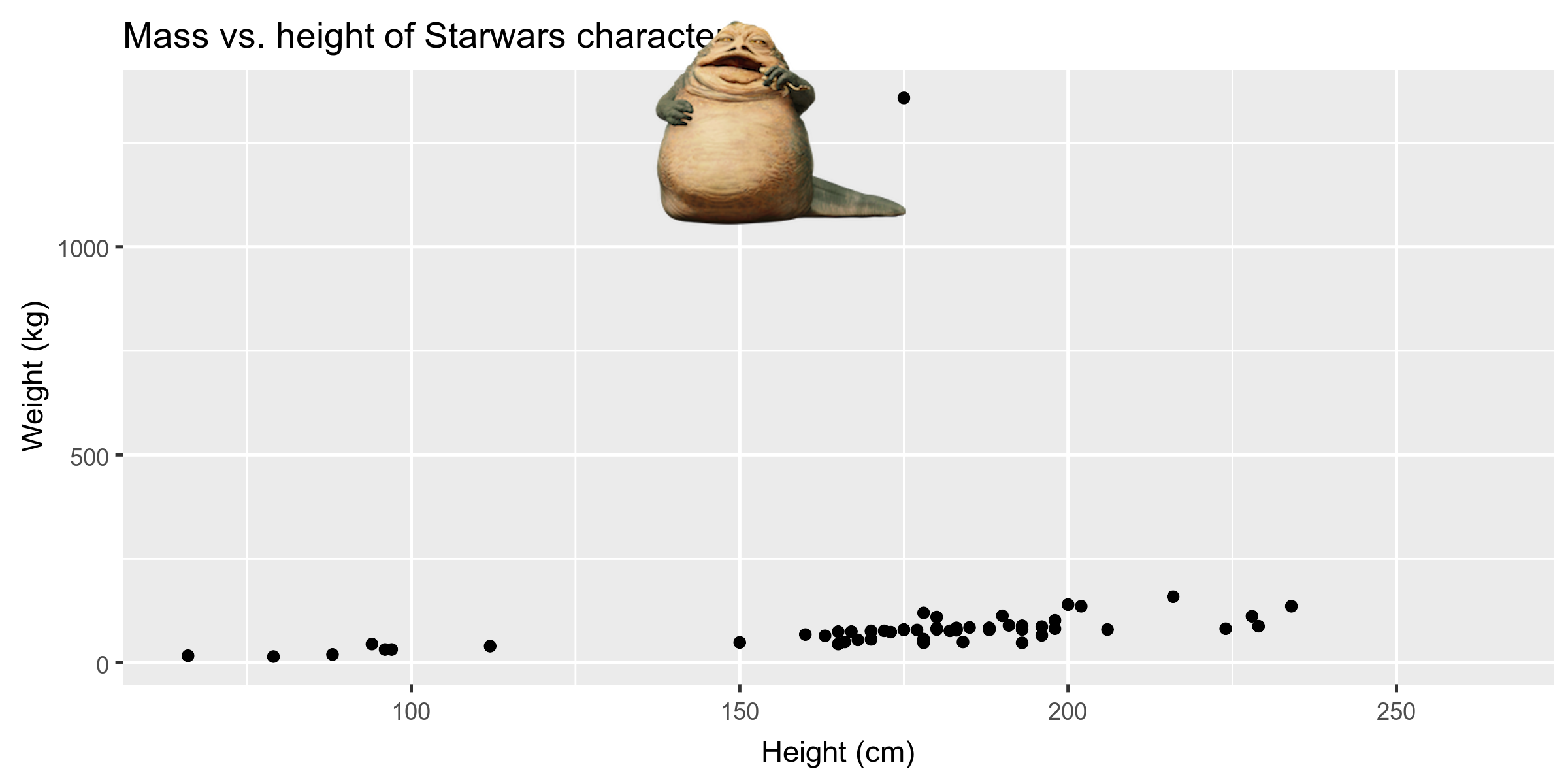Data and visualization
📉
Dr. Lucy D’Agostino McGowan
Starwars
- Go to RStudio Cloud and launch the
Starwarsproject.
Exploratory data analysis
What is EDA?
- Exploratory data analysis (EDA) is an approach to analyzing data sets to summarize its main characteristics.
- Often, this is visual. That's what we're focusing on today.
- But we might also calculate summary statistics and perform data wrangling/manipulation/transformation at (or before) this stage of the analysis. That's what we'll focus on next.
Data visualization
"The simple graph has brought more information to the data analyst’s mind than any other device." — John Tukey
- Data visualization is the creation and study of the visual representation of data.
- There are many tools for visualizing data (R is one of them), and many approaches/systems within R for making data visualizations (ggplot2 is one of them, and that's what we're going to use).
ggplot2 ∈ tidyverse
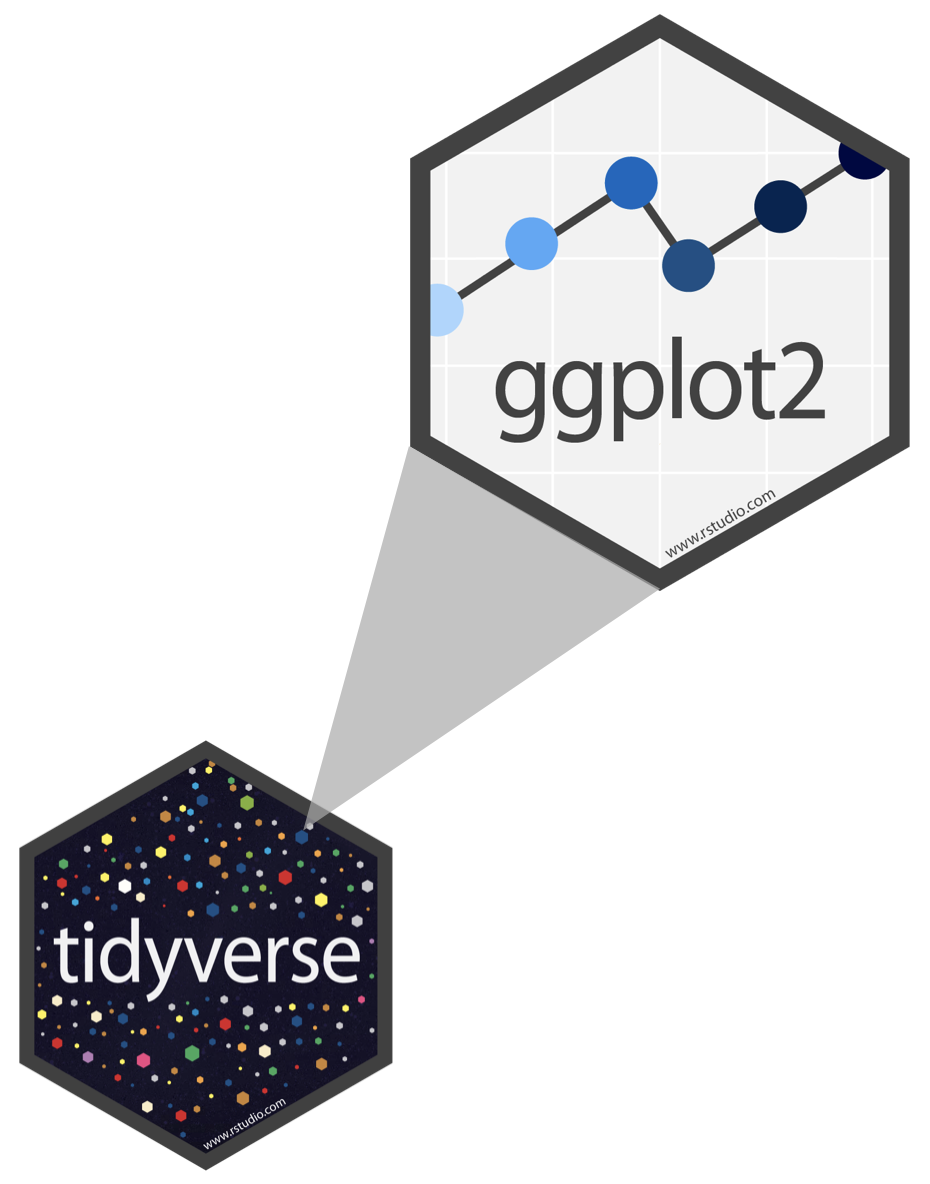
- ggplot2 is tidyverse's data visualization package
- The
ggin "ggplot2" stands for Grammar of Graphics - It is inspired by the book Grammar of Graphics by Leland Wilkinson †
- A grammar of graphics is a tool that enables us to concisely describe the components of a graphic
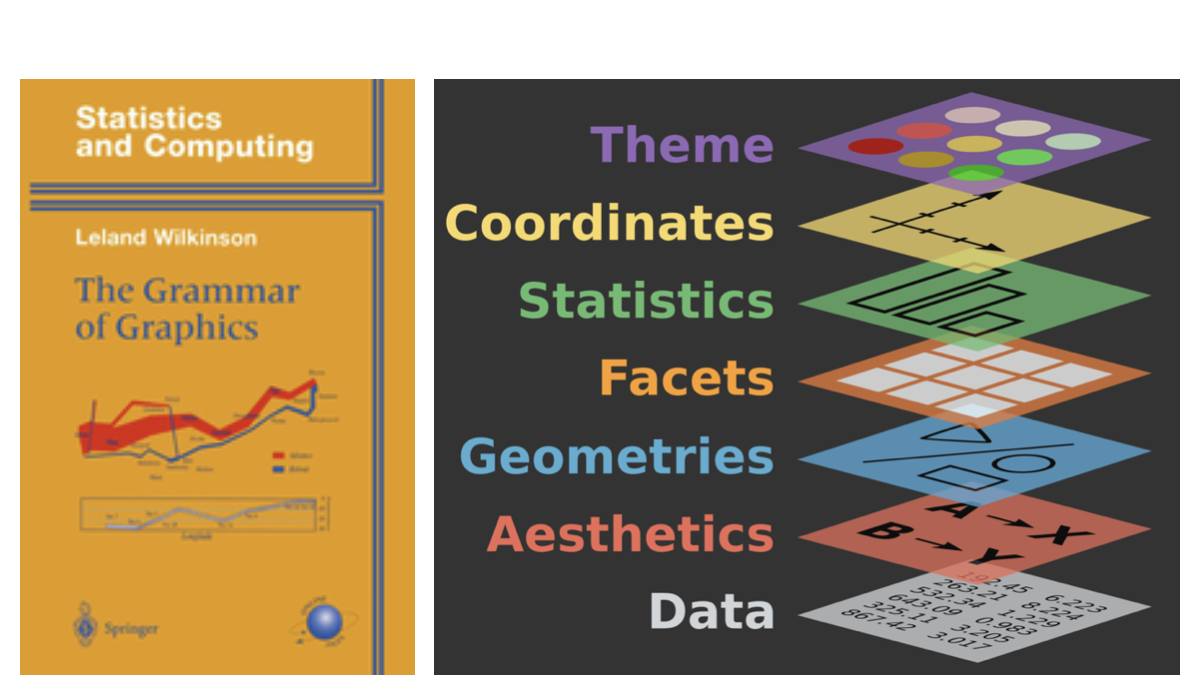
† Source: BloggoType
Which function creates the plot?
ggplot(data = starwars, mapping = aes(x = height, y = mass)) + geom_point() + labs(title = "Mass vs. height of Starwars characters", x = "Height (cm)", y = "Weight (kg)")## Warning: Removed 28 rows containing missing values (geom_point).
What is the dataset being plotted?
ggplot(data = starwars, mapping = aes(x = height, y = mass)) + geom_point() + labs(title = "Mass vs. height of Starwars characters", x = "Height (cm)", y = "Weight (kg)")## Warning: Removed 28 rows containing missing values (geom_point).
Which variables are on the x-axis and y-axis?
ggplot(data = starwars, mapping = aes(x = height, y = mass)) + geom_point() + labs(title = "Mass vs. height of Starwars characters", x = "Height (cm)", y = "Weight (kg)")## Warning: Removed 28 rows containing missing values (geom_point).
What about that warning?
ggplot(data = starwars, mapping = aes(x = height, y = mass)) + geom_point() + labs(title = "Mass vs. height of Starwars characters", x = "Height (cm)", y = "Weight (kg)")## Warning: Removed 28 rows containing missing values (geom_point).
What does geom_smooth() do? What else changed between the previous plot and this one?
ggplot(data = starwars, mapping = aes(x = height, y = mass)) + geom_point() + geom_smooth() + labs(title = "Mass vs. height of Starwars characters", x = "Height (cm)", y = "Weight (kg)")
Hello ggplot2!
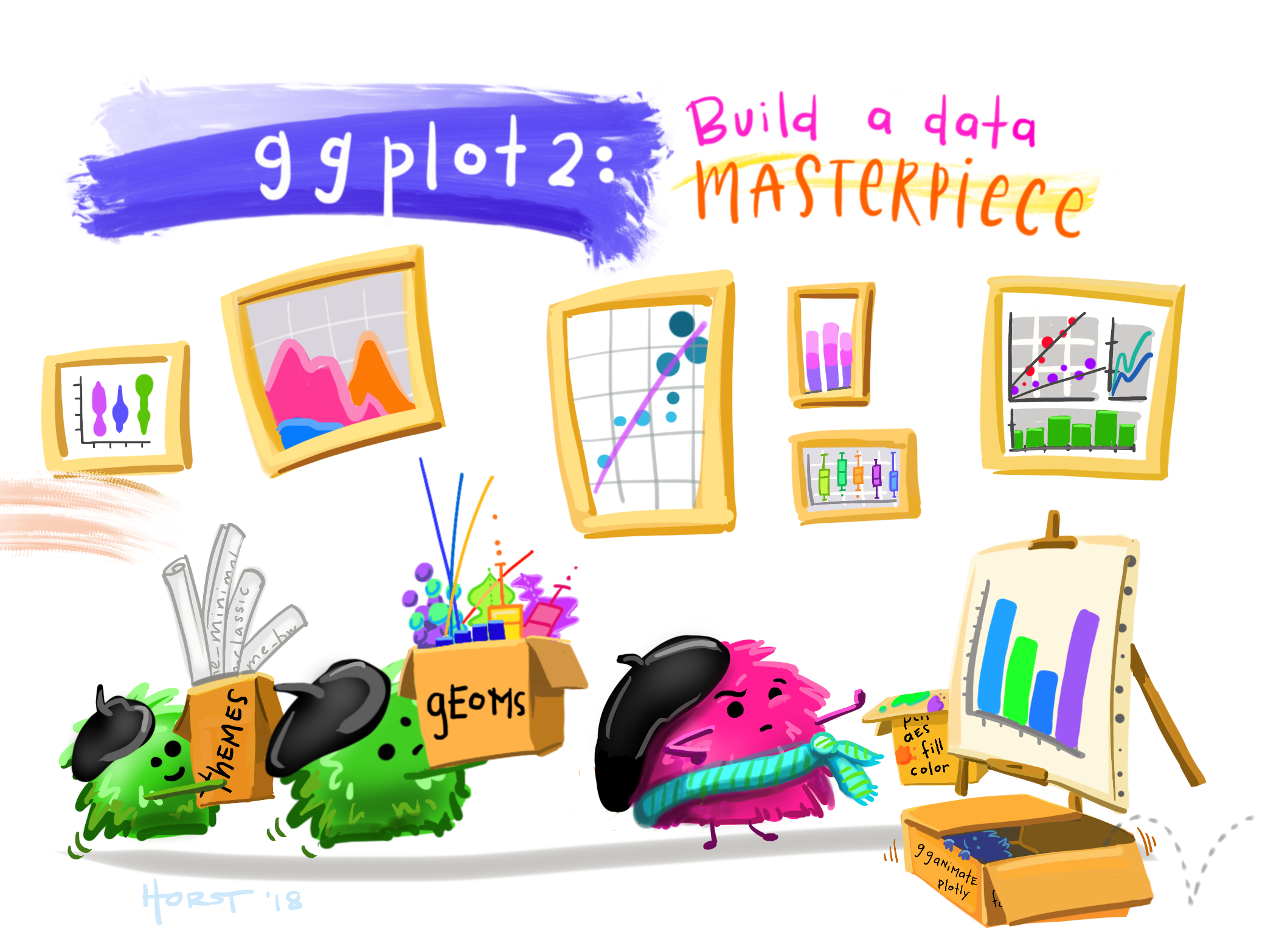
ggplot2 components
- data
- aesthetic mapping
- layer(s)
Hello ggplot2!
ggplot()is the main function in ggplot2 and plots are constructed in layers- The structure of the code for plots can often be summarized as
ggplot + geom_xxxHello ggplot2!
ggplot()is the main function in ggplot2 and plots are constructed in layers- The structure of the code for plots can often be summarized as
ggplot + geom_xxxor, more precisely
ggplot(data = [dataset], mapping = aes(x = [x-variable], y = [y-variable])) + geom_xxx() + other optionsHello ggplot2!
- To use ggplot2 functions, first load tidyverse
library(tidyverse)Hello ggplot2!
- To use ggplot2 functions, first load tidyverse
library(tidyverse)- For help with the ggplot2, see ggplot2.tidyverse.org
Dataset terminology
What does each row represent? What does each column represent?
starwars## # A tibble: 5 x 13## name height mass hair_color skin_color eye_color birth_year gender## <chr> <int> <dbl> <chr> <chr> <chr> <dbl> <chr> ## 1 Luke… 172 77 blond fair blue 19 male ## 2 C-3PO 167 75 <NA> gold yellow 112 <NA> ## 3 R2-D2 96 32 <NA> white, bl… red 33 <NA> ## 4 Dart… 202 136 none white yellow 41.9 male ## 5 Leia… 150 49 brown light brown 19 female## # … with 5 more variables: homeworld <chr>, species <chr>, films <list>,## # vehicles <list>, starships <list>Dataset terminology
What does each row represent? What does each column represent?
starwars## # A tibble: 5 x 13## name height mass hair_color skin_color eye_color birth_year gender## <chr> <int> <dbl> <chr> <chr> <chr> <dbl> <chr> ## 1 Luke… 172 77 blond fair blue 19 male ## 2 C-3PO 167 75 <NA> gold yellow 112 <NA> ## 3 R2-D2 96 32 <NA> white, bl… red 33 <NA> ## 4 Dart… 202 136 none white yellow 41.9 male ## 5 Leia… 150 49 brown light brown 19 female## # … with 5 more variables: homeworld <chr>, species <chr>, films <list>,## # vehicles <list>, starships <list>- Each row is an observation
- Each column is a variable
What's in the Star Wars data?
Take a glimpse at the data:
glimpse(starwars)## Observations: 87## Variables: 13## $ name <chr> "Luke Skywalker", "C-3PO", "R2-D2", "Darth Vader", "L…## $ height <int> 172, 167, 96, 202, 150, 178, 165, 97, 183, 182, 188, …## $ mass <dbl> 77.0, 75.0, 32.0, 136.0, 49.0, 120.0, 75.0, 32.0, 84.…## $ hair_color <chr> "blond", NA, NA, "none", "brown", "brown, grey", "bro…## $ skin_color <chr> "fair", "gold", "white, blue", "white", "light", "lig…## $ eye_color <chr> "blue", "yellow", "red", "yellow", "brown", "blue", "…## $ birth_year <dbl> 19.0, 112.0, 33.0, 41.9, 19.0, 52.0, 47.0, NA, 24.0, …## $ gender <chr> "male", NA, NA, "male", "female", "male", "female", N…## $ homeworld <chr> "Tatooine", "Tatooine", "Naboo", "Tatooine", "Alderaa…## $ species <chr> "Human", "Droid", "Droid", "Human", "Human", "Human",…## $ films <list> [<"Revenge of the Sith", "Return of the Jedi", "The …## $ vehicles <list> [<"Snowspeeder", "Imperial Speeder Bike">, <>, <>, <…## $ starships <list> [<"X-wing", "Imperial shuttle">, <>, <>, "TIE Advanc…What's in the Star Wars data?
How many rows and columns does this dataset have? What does each row represent? What does each column represent?
Run the following in the Console to view the help
?starwars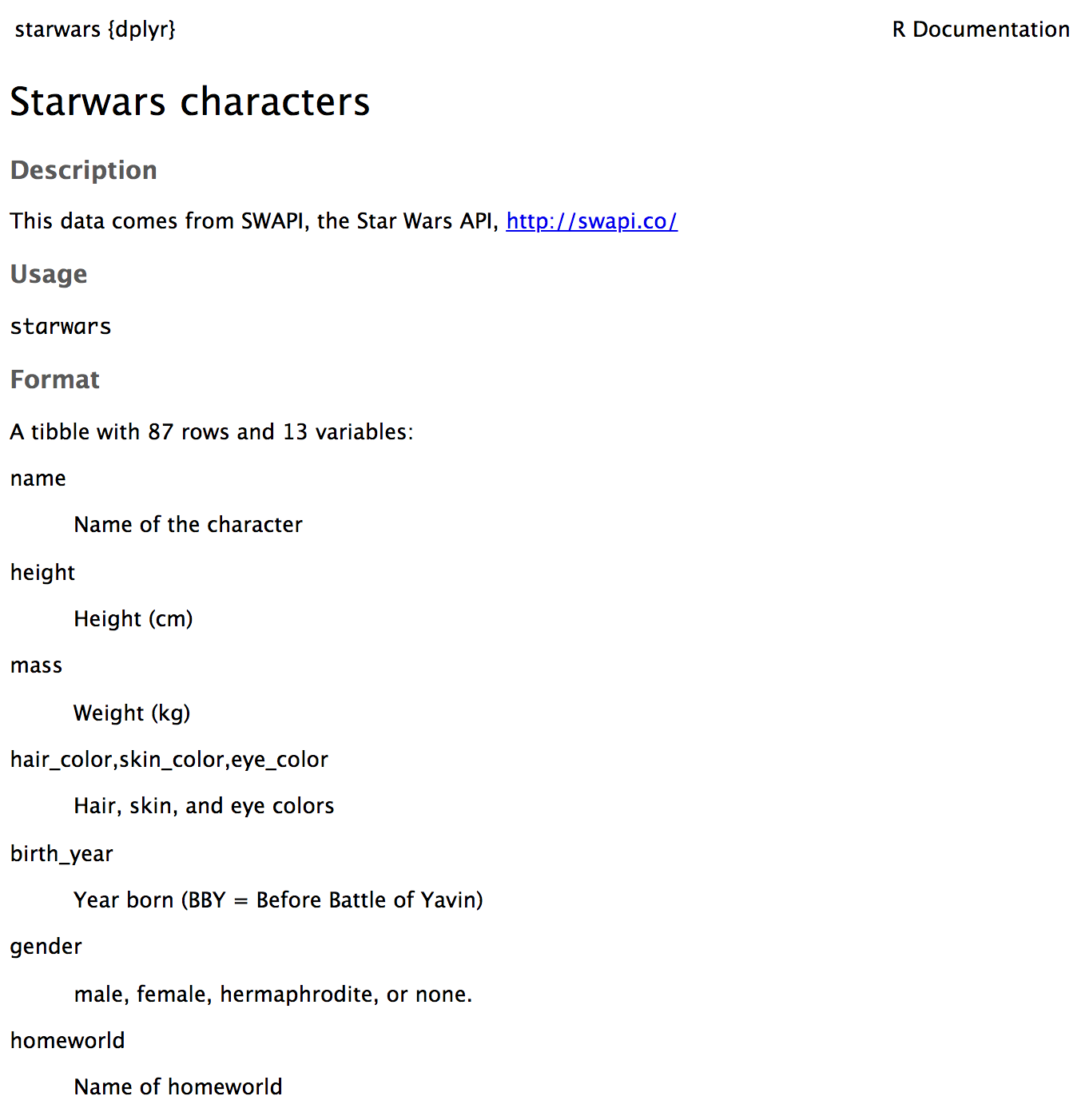
Mass vs. height
ggplot(data = starwars, mapping = aes(x = height, y = mass)) + geom_point()## Warning: Removed 28 rows containing missing values (geom_point).
What's that warning?
- Not all characters have height and mass information (hence 28 of them not plotted)
## Warning: Removed 28 rows containing missing values (geom_point).- Going forward I'll suppress the warning to save room on slides, but it's important to note it
Mass vs. height
How would you describe this relationship? What other variables would help us understand data points that don't follow the overall trend? Who is the not so tall but really chubby character?
ggplot(data = starwars, mapping = aes(x = height, y = mass)) + geom_point() + labs(title = "Mass vs. height of Starwars characters", x = "Height (cm)", y = "Weight (kg)")
Additional variables
We can map additional variables to various features of the plot:
- aesthetics
- color
- size
- shape
- alpha (transparency)
- faceting: small multiples displaying different subsets
Aesthetics options
Visual characteristics of plotting characters that can be mapped to a specific variable in the data are
colorsizeshapealpha(transparency)
Mass vs. height + gender
ggplot(data = starwars, mapping = aes(x = height, y = mass, color = gender)) + geom_point()
Mass vs. height + gender
Let's map the size to birth_year:
ggplot(data = starwars, mapping = aes(x = height, y = mass, color = gender, size = birth_year )) + geom_point()
Mass vs. height + gender
Let's now increase the size of all points not based on the values of a variable in the data:
ggplot(data = starwars, mapping = aes(x = height, y = mass, color = gender)) + geom_point(size = 2)
Aesthetics summary
- Continuous variable are measured on a continuous scale
- Discrete variables are measured (or often counted) on a discrete scale
| aesthetics | discrete | continuous |
|---|---|---|
| color | rainbow of colors | gradient |
| size | discrete steps | linear mapping between radius and value |
| shape | different shape for each | shouldn't (and doesn't) work |
- Use aesthetics for mapping features of a plot to a variable, define the features in the geom for customization not mapped to a variable
Faceting options
- Smaller plots that display different subsets of the data
- Useful for exploring conditional relationships and large data
ggplot(data = starwars, mapping = aes(x = height, y = mass)) + facet_grid(. ~ gender) + geom_point() + labs(title = "Mass vs. height of Starwars characters", subtitle = "Faceted by gender", x = "Height (cm)", y = "Weight (kg)")
Dive further...
In the next few slides describe what each plot displays. Think about how the code relates to the output.
Dive further...
In the next few slides describe what each plot displays. Think about how the code relates to the output.
The plots in the next few slides do not have proper titles, axis labels, etc. because we want you to figure out what's happening in the plots. But you should always label your plots!
ggplot(data = starwars, mapping = aes(x = height, y = mass)) + geom_point() + facet_grid(gender ~ .)
ggplot(data = starwars, mapping = aes(x = height, y = mass)) + geom_point() + facet_grid(. ~ gender)
ggplot(data = starwars, mapping = aes(x = height, y = mass)) + geom_point() + facet_wrap(~ eye_color)
Facet summary
facet_grid():- 2d grid
rows ~ cols- use
.for no split facet_wrap(): 1d ribbon wrapped into 2d
More ggplot2 info:
ggplot2 in 2
https://leanpub.com/ggplot2in2/c/sta-212-f19
Starwars
- Go to RStudio Cloud and launch the
Starwarsproject. - Open and knit the R Markdown document
Types of variables
- Numerical variables (quantitative variables) can be classified as continuous or discrete based on whether or not the variable can take on an infinite number of values or only non-negative whole numbers, respectively.
- If the variable is categorical, we can determine if it is ordinal based on whether or not the levels have a natural ordering.
Visualizing numerical data
Describing shapes of numerical distributions
- shape:
- skewness: right-skewed, left-skewed, symmetric (skew is to the side of the longer tail)
- modality: unimodal, bimodal, multimodal, uniform
- center: mean (
mean), median (median), mode (not always useful) - spread: range (
range), standard deviation (sd), inter-quartile range (IQR) - unusual observations
Histograms
ggplot(data = starwars, mapping = aes(x = height)) + geom_histogram(binwidth = 10)
Density plots
ggplot(data = starwars, mapping = aes(x = height)) + geom_density()
Side-by-side box plots
ggplot(data = starwars, mapping = aes(y = height, x = gender)) + geom_boxplot()
Side-by-side box plots
ggplot(data = starwars, mapping = aes(y = height, x = gender)) + geom_boxplot(outlier.shape = NA) + geom_jitter()
Visualizing categorical data
Bar plots
ggplot(data = starwars, mapping = aes(x = gender)) + geom_bar()
Segmented bar plots, counts
ggplot(data = starwars, mapping = aes(x = gender, fill = hair_color)) + geom_bar()
Segmented bar plots, proportions
ggplot(data = starwars, mapping = aes(x = gender, fill = hair_color)) + geom_bar(position = "fill") + labs(y = "proportion")
Which plot is more appropriate?
Which plot is a more useful representation for visualizing the relationship between gender and height?


